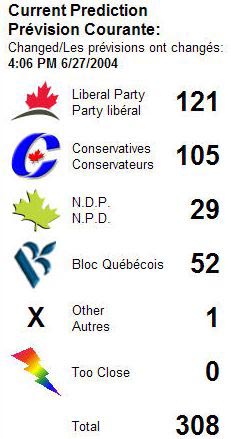 |
|
|
With election day only hours away, Milton Chan and the folks at the Election Prediction Project are predicting a Liberal minority government, which in coalition with the New Democratic Party would leave the Liberals five seats short of a majority with which to conduct the parliamentary affairs of all Canadians.
Based on an EKOS poll conducted with 5,254 respondents, on behalf of the Toronto Star, EKOS’ seat projection model predicts the Liberals coming out slightly on top with 117 seats, with 109 seats for the Conservatives, 55 for the Bloc Québécois and 27 seats for the NDP, a whopping gain of 13 seats.
 |
As you can see on the graph to your left, the Election Prediction Project calls for 121 seats for the Liberals, with 105 for the Conservatives, 29 for the New Democratic Party, 52 for the Bloc Québécois, one independent (that would be former Alliance MP Chuck Cadman, running in the B.C. riding of Surrey North), and a shutout for the Greens.
Province by province, the Election Prediction Project (EPP) predicts …
- British Columbia: 23 seats for the Conservatives, 7 for the NDP, and 5 for the Liberals. This result would see a gain of 5 for the NDP, 1 for the Liberals, and a loss of 2 for the Tories.
- Alberta: Conservatives: 27; Liberals 1. David Kilgour keeps his Edmonton-Beaumont seat, while former PC leader Joe Clark’s support notwithstanding, Deputy Prime Minister Anne McLellan looks to be going down to defeat to Tory candidate Laurie Hawn in Edmonton Centre.
- Saskatchewan and Manitoba: Conservatives, 15; Liberals, 4; and NDP 4 — which represents a loss of 2 for each of the Liberals and the NDP, and consequent gains for the Tories. Former Winnipeg mayor Glen Murray looks to lose in Charleswood-St.James to Conservative Steven Fletcher.
- Ontario: ‘In seat rich Ontario’ (how many times have you heard that phrase during this election campaign?), the Liberals have mounted something of a comeback, and are expected to take 66 out of a possible 106 seats (a drop of 29 seats), while the Tories may pick up 28 seats for a total of 32, and the NDP gains 5 for a total of 7, including leader Jack Layton, his wife Olivia Chow and former NDP leader Ed Broadbent.
- Québec: Bloc Québécois, 52, and Liberals, 23 (a loss of 14 seats in Prime Minister Martin’s home province). A large undecided could push the Liberal seat total a little higher, but pretty much whatever the election results tomorrow evening, the Bloc will hold the balance of power in our nation’s capitol come Tuesday morning.
- The Maritimes: The Liberals look to hold on to 20 seats, a drop of one from the time of dissolution of the most recent Parliament, while the Tories drop one seat for a total of 5, and the NDP gain 1, for a total of 5 Maritime seats.
The seat projection models are significant because late last week Prime Minister Martin declared that whichever party wins the most seats should be declared the winner, even if it did not win the required 155 seats needed to form a majority government.
Needless to say, the seat projections provide a recipe for an extremely fragile House of Commons, one that rests on the support of a separatist party and a slightly re-energized party of the left.
As election results start to roll in on Monday night, British Columbia will still be voting and the results are likely to be so close that west coast voters could end up steering the final outcome.
As EKOS president Frank Graves told the Star, “B.C. voters have essentially moved from bystanders to final arbiters in this election.”